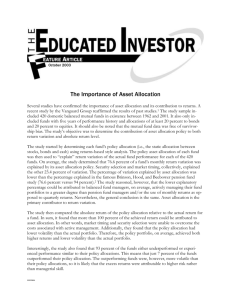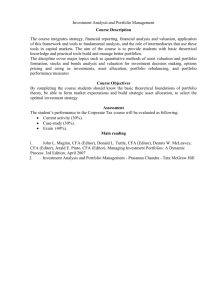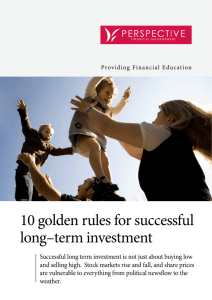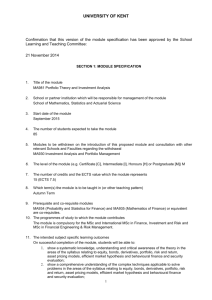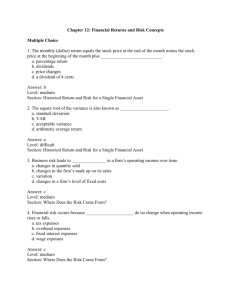Determinants of Portfolio Performance— 20 Years Later
advertisement
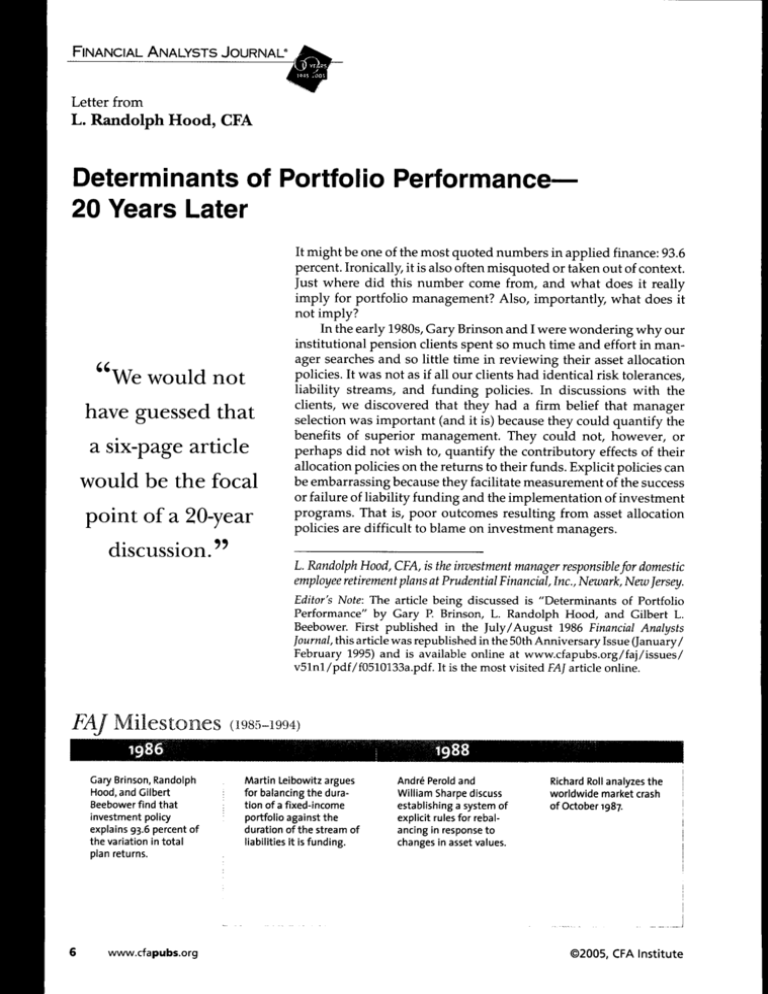
FINANCIAL ANALYSTS JOURNAL- Letter from L. Randolph Hood, CFA Determinants of Portfolio Performance— 20 Years Later We would not have guessed that a six-page article would be the focal point of a 20-year discussion." It might be one of the most quoted numbers in applied finance: 93.6 percent. Ironically, it is also often misquoted or taken out of context. Just where did this number come from, and what does it really imply for portfolio management? Also, importantly, what does it not imply? In the early 1980s, Gary Brinson and I were wondering why our institutional pension clients spent so much time and effort in manager searches and so little time in reviewing their asset allocation policies. It was not as if all our clients had identical risk tolerances, liability streams, and funding policies. In discussions with the clients, we discovered that they had a firm belief that manager selection was important (and it is) because they could quantify the benefits of superior management. They could not, however, or perhaps did not wish to, quantify the contributory effects of their allocation policies on the returns to their funds. Explicit policies can be embarrassing because they facilitate measurement of the success or failure of liability funding and the implementation of investment programs. That is, poor outcomes resulting from asset allocation policies are difficult to blame on investment managers. L. Randolph Hood, CFA, is the investment manager responsible for domestic employee retiremen t plans at Prudential Financial, Inc., Newark, New Jersey. Editor's Note: The article being discussed is "Determinants of Portfolio Performance" by Gary P, Brinson, L, Randolph Hood, and Gilbert L, Beebower. First published in the July/August 1986 Financial Analysts Journal, this article was republished in the 50th Anniversary Issue (January/ February 1995) and is available online at www.cfapubs.org/faj/issues/ v51nl/pdf/f0510133a.pdf. It is the most visited FAJ article online. FAJ Milestones (1985-1994) 1986 Gary Brinson, Randolph Hood, and Gilbert Beebower find that investment policy explains 93,6 percent of the variation in total plan returns. www.cfapubs.org 1988 Martin Leibowitz argues for balancing the duration of a fixed-income portfolio against the duration of the stream of liabilities it is funding. Andre Perold and William Sharpe discuss establishing a system of explicit rules for rebalancing in response to changes in asset values. Richard Roll analyzes the worldwide market crash of October 1987. ©2005, CFA Institute FINANCIAL ANALYSTS JOURNAL" Our clients considered liability valuation the province of actuaries, and liabilities were far too complicated and esoteric to analyze or to use in making policy decisions. Nevertheless, we firmly believed that investment policy was the heart of the investment planning process. (And somewhat after the fact, the funding debacle of 2001-2003 illustrates allocation's importance. Over that period, plan sponsors lost billions of dollars for their shareholders—despite tremendous efforts devoted to manager selection. The culprit was asset allocation policies that were developed without adequate consideration of the range of possible outcomes or the behavior of the liabilities.) So, convinced as we were in the 1980s of the importance of allocation policy, and with the assistance of Gilbert Beebower at SEI Corporation, who had the relevant data, we set out to explore the effects of asset allocation policy on plan returns. Our main finding was that, on average, 93.6 percent of the variation of actual quarterly total returns from 1974 to 1983 of a sample of 91 large corporate pension plans could be explained by using proxy return series. The proxy series were calculated by using each plan's average weight over the 40 quarters for equities, bonds, and cash equivalents and by applying passive index returns for those asset classes for each quarter. Simply put, we found that the broad types of asset classes a fund includes in a portfolio and the proportions they represent have a profound effect on the variability of returns. These decisions also directly affect the returns themselves, of course, although we did not choose to stress that aspect. We concluded that asset allocation policy is an important component of the management process and deserves careful consideration. We wanted plan sponsors to iocus first on their liabilities and explic- 1989 Martin Fridson becomes Book Review Editor. September/October 2005 itly consider what they were trying to achieve with their plans. And with our research, we thought the point had been made. But debates about the article's findings were surprisingly numerous. Criticisms as well as defenses of the approach—and perceptions of the lessons to be learned from the article—have abounded. So, on behalf of my co-authors and myself, I would like to address some of the most prevalent observations and reactions that have been discussed in the last 20 years. I want to start with one that we believe has not been discussed much at all: Nothing in the original paper suggests that active asset management is not an important activity. It was not the point of our paper, and our goal was not to demonstrate otherwise. Although by our calculations it is true that the average plan over the time period we studied lost money from security selection and from market timing as we defined the terms, some plans did quite well. In security selection, for example (see Table 6 of the published article), the average plan active return was -0.36 percent a year, but the range of active returns varied from a loss of -2.90 percent to a gain of +3.60 percent a year—a spread of 650 bps. We would suggest that any activity that can avoid the former or attain the latter is very important indeed. Most plan sponsors appear to agree and think that what might be a small expected loss (0.36 percent) is probably worth the cost of trying to outperform. Other comments about the research have surfaced over time. Some of the early detractors dismissed the work as being applicable solely to our sample, which it was not, because the results have been repeated with other data. Other criticisms revolved around our use of policy portfolios. We 1990 Fischer Black presents a formula for deciding when and when not to hedge. "What Practitioners Need to Know" series is introduced by Bob Hagin and Mark Kritzman. Fischer Black argues that estimating expected return requires a theory to explain what factors are priced and why mispricing occurs. www.cfapubs.org FINANCIAL ANALYSTS JOURNAL" believe policy portfolios are useful and, in many ways, necessary. However, we do not believe that they are never to be changed. Naturally, when the goals or circumstances surrounding the management of portfolios change, so should the investment policy. All we would urge is that the policy be specified in advance and be actionable. As we noted in our article, we had to infer policy targets because we did not have the necessary data. If we had possessed the data, however, our results would certainly have been stronger, not weaker: Unless sponsors and managers actively disregard their policies, the policy effects would have been stronger than we measured. Another comment has been that perhaps analyzing plans as a group rather than individually across time is the important approach. However, we wanted specifically to challenge this concept. We had no reason to believe that a single asset allocation policy could possibly be right for all of our diverse clients or that the mean policy weights for a group of heterogeneous pension plans had much ex ante interest. Some commentators disliked our use of the "other" term, although it was algebraically necessary in our formulation. One interpretation of the term is that it represents the effect of overweighting managers who then reliably outperform their respective benchmarks, and vice versa, which might be of interest today to those pursuing "portable alpha" approaches. A further criticism involved our use of variation of portfolio total returns, not the returns themselves. We do not understand this point as a criticism. Understanding how something varies, in our context, leads to understanding where it will end up. Our policy portfolio return series all had regression coefficients near unity when explaining actual return series, which is not surprising given their construction, so we did not report the regression coefficients because of space constraints. In Table 6, we reported that the average annual return to the average actual portfolio was equal to its policy portfolio return less 110 bps. We thus did describe the total return, albeit indirectly because it was not our main point. At their best, the compound annual total returns of the plans we studied were not, in themselves, interesting. We thought what was www.cfapubs.org interesting was how the returns turned out to be what they were—with policy, timing, and security selection each contributing with varying degrees of importance. An analogy would be driving directions: One can either give a compass heading and a distance, or more helpfully, one can describe the route. The heading and distance information is akin to total return itself (up 9.01 percent); the variance of total return is akin to the directions: Follow the policy portfolio return wherever it leads (remember, it is specified in advance), but subtract 110 bps each year; on average, you will be right, and you can also see how bumpy the ride is along the way! Conversely, among the work's supporters, zealous marketing has apparently led some to take liberties with the research. For instance, our findings do not support the notion that "asset allocation" funds are somehow inherently superior to single-asset-class funds. The ability to forecast asset class returns is a far different matter from pointing out that the policy weights and returns will have a profound effect on the return variation—and results—of an investment strategy. Our point was solely that, in aggregate, individual asset class policies, with given weights and broad market representation for returns, appear to dominate portfolio return variations and, by extension, the returns themselves. Furthermore, this conclusion was meant to be descriptive, not prescriptive, of the process we observed. Looking back, we would not have guessed that a six-page article would be the focal point of a 20-year discussion. The consensus, however, appears to have settled in to agree with us that investment policy will be very important in subsequent results and in describing those results. Of course, other factors (such as active management and cost control) also have roles, and important roles, to play. Our message today remains the same as before: Carefully consider what goal you are trying to achieve, how important it is to achieve it, and how much risk you are willing to tolerate in pursuing it. Then, create a policy portfolio that reflects that goal and your risk tolerance for the probable outcomes—because executing that policy will have a dominant effect on your success. And, then, get to work. ©2005, CFA Institute

